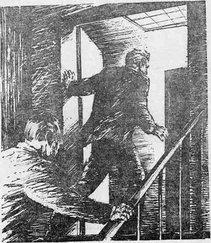Flaps : Auxiliary wing panels which can be raised or lowered in flight. They are normally used to decrease speed and increase lift prior to landing. They are also used during takeoffs and whenever it may be necessary to slow an aircraft to minimum safe speed while in flight.
Flare : This word has two aeronautical meanings. Most commonly, when an aircraft is descending for a landing, just before or above the runway the pilot will raise the nose, slowing the descent to a minimum and putting the plane in a landing attitude. This is known as flaring . Expertly done, it produces a smooth and gentle landing. Flare also means a pyrotechnic signal light, as it does elsewhere.
Flight plan : A document filed by a pilot, or a responsible crew member, before departure. It supplies information concerning the pilot’s identity, intentions, destination, alternate choice of destination in case of adverse weather, and other data. (Under some circumstances a flight plan is not legally required for cross-country trips, but prudent pilots file them anyway.)
463L ( Four-Six-Three L ): An efficient, palletized, cargo-handling system used by the Air Transport Command. Fourteen-hundred hours : 2 P.M. See also Time .
Full bore : Wide open, i.e., a maximum effort.
Full feather : To turn an aircraft’s propeller blades until they are directly edgewise to the relative wind.
Fuselage : The main body of an aircraft, excluding the wings or rotors.
G’s : Multiples of the force of gravity induced by moderate-to-severe aircraft maneuvers. Two G’s means twice the normal force of gravity; at five G’s a normally 200-pound man would weigh 1,000 pounds. Astronauts and most test pilots regularly endure such stresses, and more.
GCA .: Ground Control Approach, a radar system by means of which a pilot on final approach to landing is given continuous information as to his exact position and distance from touchdown. This term has now been largely superseded by PAR (Precision Approach Radar).
Gear down : With landing gear extended. Also, the command by the aircraft commander to extend the wheels; normally it is done by either the copilot or the flight engineer.
Glide path : A precision approach path to an instrument runway. It is marked by two highly directional radio transmitters — the glide-slope indicator (GSI) and the localizer. The latter supplies right-left indications.
Glide slope : Specifically, the designated descent path onto an instrument runway. Also, the pitch, or angle, of that path.
Go-around : The procedure laid down for a pilot to follow if he approaches an airport but cannot complete his landing as planned. It is also known as a missed approach in instrument flying. The most common cause is inadequate visibility immediately prior to an intended landing.
Goose Bay : A widely known stop on North Atlantic and certain Arctic routes. It is located in western Labrador.
Ground control : The authority that handles the movement of aircraft on the ground, exclusive of takeoffs and landings, at major airports. Ground control normally has its own special radio frequency and personnel.
Ground effect : A phenomenon which gives extra lift to aircraft just before landing. Essentially it is an added cushion built up when the air deflected downward by the wings is slightly compressed against the ground.
Hardstand : A paved area at an airport where heavy aircraft can be safely parked.
Head : A military term, originated by the Navy, that means toilet.
Heading : The exact direction in which the nose of an aircraft is pointed. It can be, and frequently is, different from the path of the aircraft over the ground or water.
Head shed : The Pentagon, in Washington, D.C. (actually in Virginia). See also Puzzle palace .
Herc : Short for Hercules , the official name of the C-130 airlifter.
HH-3 : The Air Force official designation for the twin-turbine Sikorsky rescue helicopter more popularly known as the Jolly Green Giant .
Hover-taxi : A frequently used helicopter technique; instead of rolling an aircraft along the ground on its wheels, the pilot will lift off a few feet and then fly just above the ground to where he is going. Some helicopters — those that have no wheels — do this of necessity.
Hundred-bour check : An inspection performed on aircraft after each 100 hours of use; normally it involves a minimum maintenance procedure.
IFR : Instrument Flight Rules.
ILS : Instrument Landing System.
Instrument approach : A precision approach to a properly equipped runway that can be executed by a qualified pilot solely by reference to instruments on the panel before him.
IO : Information Officer.
J Site : The common name for the BMEWS installation close to Thule.
Jigs : Tools used in the manufacturing of aircraft; essentially they hold components in proper alignment while the parts are welded or otherwise joined together.
Jolly : Short for Jolly Green Giant , the affectionate name for the Sikorsky HH-3 rescue helicopter, which gained great fame in Vietnam.
Knot : One nautical mile per hour. In round figures, fifty-two knots equals sixty miles per hour.
Latrine : Toilet.
LEM : Lunar Excursion Module.
Letdown : An aircraft’s descent from cruising altitude to a position where it can enter the landing pattern of its destination airport.
Loadmaster : A respected and highly skilled crew member who is responsible for the loading and unloading of an airlifter. He also makes certain that the load does not exceed allowable limits, is properly distributed, and is securely fastened down.
Long-legged : Having long-range capability.
Long-range cruise : An engine setting designed to get the maximum number of miles out of the available fuel at the sacrifice of some speed.
LORAN : An acronym for LOng RAnge Navigation ; it is an electronic system, requiring specialized equipment capable of receiving two coupled transmitting stations simultaneously. LORAN is particularly effective over large bodies of water.
MAC : Military Airlift Command.
Mag drop : In almost all instances, aircraft piston engines have dual magnetos for greater ignition reliability. During normal operations both systems are continuously operated. Prior to takeoff, it is customary to run each engine for a brief test period on first one magneto and then the other to insure that both are functioning properly. The loss in rpm when running on either single magneto is known as the mag drop .
Mags : Magnetos, the alternators used to supply ignition to internal combustion engines; most aircraft piston engines have two for additional reliability.
Manifold pressure : The standard method for measuring the power output of an airborne piston engine.
Materiel : Military equipment and supplies.
Max gross : The theoretical maximum gross weight of an aircraft, including its fuel and payload, at which it can safely take off and fly.
Medevac : The transportation of medical patients by air; also, the special system set up to accomplish this.
Mixmaster : The popular name for the Bendix octant widely used by aerial navigators during World War II. See also Bendix Mixmaster .
Moonlight-requisition : A time-honored military technique for obtaining needed supplies or equipment which cannot conveniently be had through normal channels; it consists of helping yourself when no one is looking.
Читать дальше












